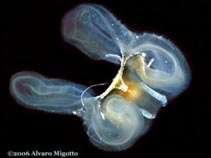Leucothea multicornis (Quoy & Gaimard, 1824)
Classification / Names Common names | Synonyms | CoL | ITIS | WoRMS
Tentaculata | Lobata | Leucotheidae
Environment: milieu / climate zone / depth range / distribution range Ecology
Pelagic. Subtropical
Distribution Countries | FAO areas | Ecosystems | Occurrences | Introductions
Western Pacific, Western Atlantic and the Mediterranean.
Length at first maturity / Size / Weight / Age
Maturity: Lm ? range ? - ? cm Max length : 25.0 cm H male/unsexed; (Ref. 1610)
Life cycle and mating behavior Maturity | Reproduction | Spawning | Eggs | Fecundity | Larvae
Main reference
References | Coordinator | Collaborators
Madin, L.P. 1991 Distribution and taxonomy of Zooplankton in the Alboran Sea and Adjacent Mediterranean sea. A literature Survey and field guide. Woods Hole Oceanographic Institute Technical Report WHOI-91-26. 200 p. (Ref. 1610)
IUCN Red List Status
(Ref. 130435: Version 2025-1)
CITES status (Ref. 108899)
CMS (Ref. 116361)
Threat to humans
Human uses
| FishSource |
Tools
More information
Diet composition
Food consumption
Predators
Max. ages / sizes
Length-weight rel.
Length-length rel.
Length-frequencies
Mass conversion
Abundance
Internet sources
BHL | BOLD Systems | CISTI | DiscoverLife | FAO(Publication : search) | Fishipedia | GenBank (genome, nucleotide) | GloBI | Gomexsi | Google Books | Google Scholar | Google | PubMed | Tree of Life | Wikipedia (Go, Search) | Zoological Record



